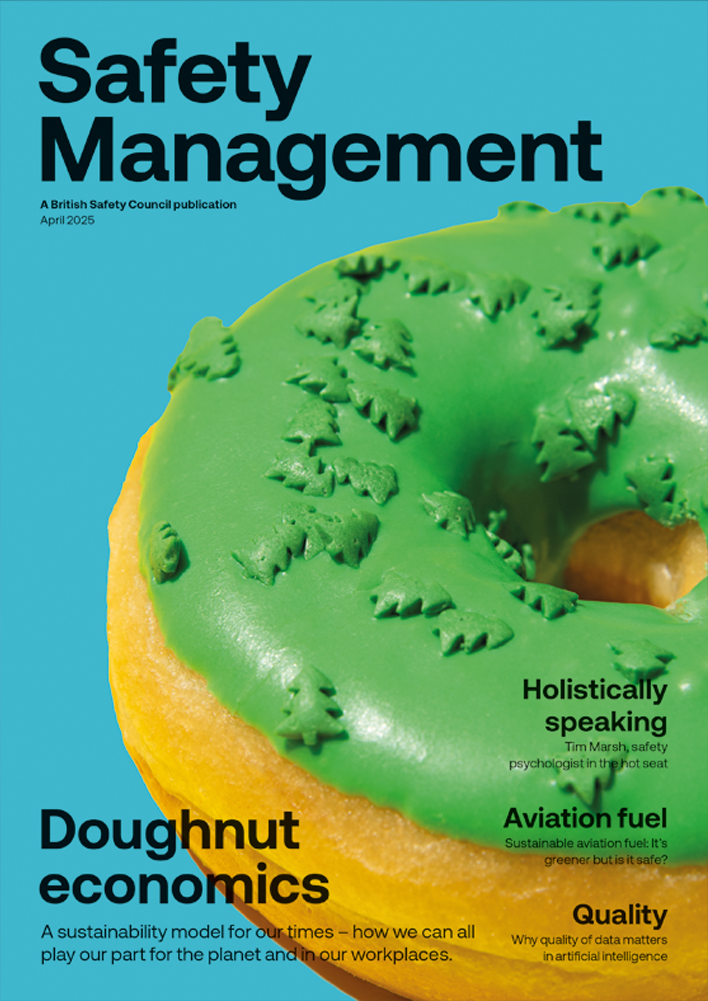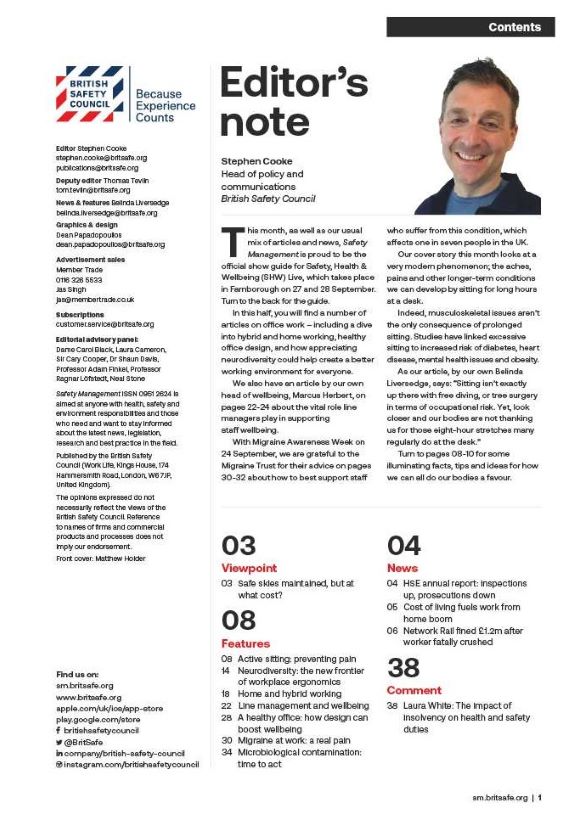Safety psychologist, Dr Tim Marsh is a well-known figure on the international conference and events circuit, regularly giving talks on the importance of taking a holistic approach to health, safety and wellbeing.
Features
Holistically speaking: an interview with safety psychologist Dr Tim Marsh
Dr Marsh has long been a proponent of building strong organisational cultures, within which everybody buys in to the theory that taking care of workers’ mental and physical wellbeing is key to ensuring they stay safe and are able to thrive in the workplace.
He is one half of Anker and Marsh, a consultancy he runs alongside Jason Anker MBE, who was paralysed in the early 1990s after falling from a ladder at work and who went on to help others avoid the same fate by sharing his experience in his capacity as a motivational speaker. To learn more about Anker’s story, see this article he wrote for Safety Management in 2022.
Earlier this year, Dr Marsh teamed up with the British Safety Council to publish a book of his insights on health, safety and wellbeing over the years, with all proceeds being donated to mental health charities Mates in Mind and Brawd. The book, entitled Tim Marsh’s Musings: Wisdom and Wit from a Safety Psychologist, can be downloaded, once a small donation has been made, using this link.

Safety Management caught up with Dr Marsh after the book’s launch at the SHW Live event in Manchester, to find out what makes him tick, why he does what he does, and what comes next.
At what point in your career did you first realise the importance of taking care of workers’ wellbeing and mental health in addition to their physical safety? Was there a particular event that triggered this?
My first job as a psychologist was looking into new recruits who were dying by suicide in the Army. It turned out to be simple research – if you’re suited to barrack/army life you might never want to leave. If, on the other hand, you’re not suited, then even basic training (back then) could be pretty horrendous. In the early 1990s though, the phone rang only from companies seeking behavioural safety support, so I spent lots of that decade on oil rigs and in chemical plants, etc.
Brawd, the charity you chose to support through the proceeds of the book you published with the British Safety Council, is focused on men’s mental health and wellbeing. Why is this charity’s work so close to your heart?
As a psychologist, mental health has always been close to my heart and like almost everyone else, as the years have gone by, I’ve seen many people I love struggle. More recently, and specifically, Brawd really helped someone close to me. And when I say they really helped, I mean that, on one particular night, Brawd most probably directly saved his life.
You’ve worked with major organisations to help them improve organisational safety. What would you say are the three most important elements that employers need to get right, to keep people safe, happy and healthy at work?
The short answer is quite easy: management commitment to a strong culture is utterly key (as it ever was) and that manifests in three simple ways. First, the basics of systems, procedures, training and the like. When we’ve reached diminishing returns with these, as many have, then excellence is powered by two things: learning, and engagement and empowerment.
 Tim Marsh: "I’ve seen many people I love struggle."
Tim Marsh: "I’ve seen many people I love struggle."
As an illustration, the simple ‘safety differently’ question covers all three: “I want you to make us money without hurting yourself and while enjoying your work.” Stating this genuinely and using the answers in the best way we feasibly can means we won’t go far wrong – especially as the answers might cover diversity, task design, levels of autonomy, communication and traction, in addition to many other issues over and above workload that plug into ‘good work’. Because a good day at work is better for your mental health than not needing to work at all.
Can you explain when and how you first met Jason Anker, and how Anker and Marsh started?
Jason and I had always been friendly from the speaking circuit. One day, he asked me how he might grow his business, and I said, “add a consultancy element, much like my old company, Ryder-Marsh”. I was semi-retired at the time, having stepped back because of a family illness.
Later, as I was helping him get a project over the line as a friend, someone from his partner organisation suggested: “You two really should work together”. After the meeting, we went for a beer and a hotdog and one of us laughingly said: “Do you know…?”. Jason claims it was my idea but I’m adamant it was his! Neither of us cares, and it’s the closest we’ve ever come to disagreeing.
 Tim (left) with Jason Anker (right) after winning an award in Abu Dhabi for Outstanding Contribution Award to HSE
Tim (left) with Jason Anker (right) after winning an award in Abu Dhabi for Outstanding Contribution Award to HSE
How do you respond to people who still say that wellbeing and mental health should sit outside the health and safety remit?
I feel strongly that the best approaches to just about anything at all are holistic, integrated and proactive – all key elements of risk management when considering human error. People who are really struggling are more likely to be distracted, less situationally aware, more fatalistic and less likely to have good quality dialogue and to make good decisions. These factors are often behind safety incidents in the workplace.
To give two simple case studies: Jason himself is adamant that his accident was caused by poor wellbeing. It was being tired and fatalistic that led him to use a ladder he knew to be unsafe – even though he did ‘take five’. But having ‘taken five’ and thought, “risky”, he simply thought, “oh, f**k it”.
Or, from Laura Thomas – the former barrister-turned-safety consultant – who says: “In all the health and safety court cases I was involved in over the years, the one constant was that someone in the middle of it all was having a really bad day.”
From when you first started talking and writing about mental health and wellbeing in an organisational context to now, what changes have you seen in attitudes and actions from employers?
I remember writing an article on mental health and safety for a magazine about eight years ago and the article was stuck with various committees for months, because it was deemed as “potentially highly controversial”. It turned out not to be and it’s not at all controversial now – especially as we get better at articulating the win-win and generic nature of it all. So, that’s the obvious change: we’ve stopped shouting safety and whispering health.
Having said that, however, I do not believe that long-term health issues caused by exposure to hazards in the workplace get anywhere near the attention they deserve.
You wrote in the book about the importance of communicating with workers in language that they use and making it easy for people to talk about issues of concern before they reach crisis point. How can employers create an environment in which this can happen?
 Tim Marsh speaking at SHW Live earlier this year. Photograph: Stephen Cooke
Tim Marsh speaking at SHW Live earlier this year. Photograph: Stephen Cooke
It’s a basic and useful element of neuro-linguistic programming (NLP): use the language that’s in the other person’s head to best connect with them. For example, whatever sense you use to describe something will be mirrored by any good salesman.
If you hear what I’m saying and see where I’m going with this, it’ll probably feel good to you!
I often use a pie slice diagram to illustrate in a user-friendly way how good or bad a day someone is having. But while it makes for a user-friendly diagram, no-one ever says to themselves when having a really bad day: “Oh bother, I’m having a big blue pie-slice day today.” The words in their head will almost certainly be something far earthier.
British Safety Council in its manifesto last year called for a national wellbeing strategy and the appointment of a dedicated Minister for Wellbeing. What role would you like to see the government play in ensuring that workplaces take better care of people’s wellbeing?
Pretty much exactly as described in the British Safety Council manifesto! There is a compelling win-win argument to be made, and I welcome the current government’s apparent focus on wellbeing in the longer term.
What’s next for Tim Marsh?
I’d say, at my age, retirement! But being near the forefront of something so important – alongside Jason, especially – gives me lots of energy. So, as well as the consultancy, I’ve got three books out early this year (including the charity one with British Safety Council) and a new one with Jason about mental health and wellbeing specifically in the preparation stage…
Tim Marsh’s Musings: Wisdom and Wit from a Safety Psychologist can be downloaded, once a small donation has been made, using this link:
FEATURES

Why quality data is essential when using AI for occupational safety and health management
By Dr Bob Rajan-Sithamparanadarajah. Safety Groups UK (SGUK) on 01 April 2025
Artificial intelligence-powered models, systems and technology have the potential to significantly improve the management of occupational safety and health (OSH) risks, but it is vital that OSH practitioners understand the limitations and dangers of using AI to protect people at work.

Sustainable aviation fuels: how do we put the SAFety in SAF?
By Megan Hine, Draeger Safety UK on 01 April 2025
Sustainable aviation fuel is seen as having great potential to reduce the greenhouse gas emissions from air transportation. However, as with other emerging renewable energy sources, the safety risks arising from the production, processing and storage of these biofuels can be accompanied by new risks and will require careful management from the safety industry as utilisation increases to meet the Government’s mandatory targets.

Why social sustainability should be a priority for health, safety, environmental and compliance professionals
By Agnes Chruszcz, IEMA (Institute of Environmental Management and Assessment) on 01 April 2025
By embedding social sustainability principles into their policies and operations, organisations can not only improve quality of life for their employees, workers in their supply chains and the communities they interact with, but boost their business resilience, productivity and reputation.



